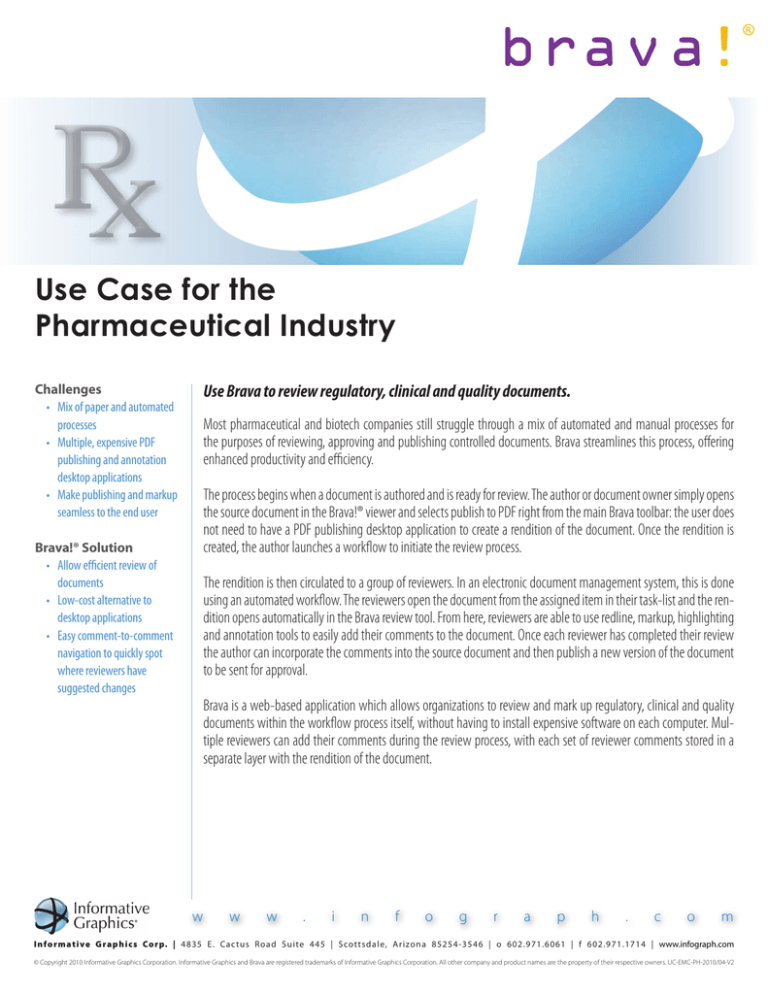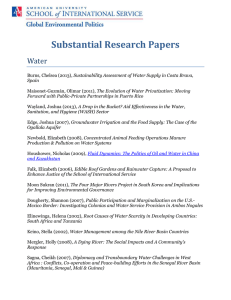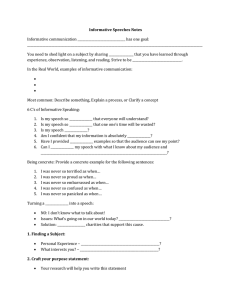Use Case for the Pharmaceutical Industry
advertisement

Use Case for the Pharmaceutical Industry Use Brava to review regulatory, clinical and quality documents. Challenges • Mix of paper and automated processes • Multiple, expensive PDF publishing and annotation desktop applications • Make publishing and markup seamless to the end user Most pharmaceutical and biotech companies still struggle through a mix of automated and manual processes for the purposes of reviewing, approving and publishing controlled documents. Brava streamlines this process, offering enhanced productivity and efficiency. The process begins when a document is authored and is ready for review. The author or document owner simply opens the source document in the Brava!® viewer and selects publish to PDF right from the main Brava toolbar: the user does not need to have a PDF publishing desktop application to create a rendition of the document. Once the rendition is created, the author launches a workflow to initiate the review process. Brava!® Solution • Allow efficient review of documents • Low-cost alternative to desktop applications • Easy comment-to-comment navigation to quickly spot where reviewers have suggested changes The rendition is then circulated to a group of reviewers. In an electronic document management system, this is done using an automated workflow. The reviewers open the document from the assigned item in their task-list and the rendition opens automatically in the Brava review tool. From here, reviewers are able to use redline, markup, highlighting and annotation tools to easily add their comments to the document. Once each reviewer has completed their review the author can incorporate the comments into the source document and then publish a new version of the document to be sent for approval. Brava is a web-based application which allows organizations to review and mark up regulatory, clinical and quality documents within the workflow process itself, without having to install expensive software on each computer. Multiple reviewers can add their comments during the review process, with each set of reviewer comments stored in a separate layer with the rendition of the document. w w w . i n f o g r a p h . c o m In fo rm at i ve G ra p h i c s Co rp. | 4835 E. Cac tus R oad Suite 445 | S cottsdale, Ar izona 85254-3546 | o 602.971.6061 | f 602.971.1714 | www.infograph.com © Copyright 2010 Informative Graphics Corporation. Informative Graphics and Brava are registered trademarks of Informative Graphics Corporation. All other company and product names are the property of their respective owners. UC-EMC-PH-2010/04-V2 Use Case for the Pharmaceutical Industry Challenges • Restrict document viewing so they cannot be manipulated • Allow access to content while controlling what can be done with it • Control printed copies in circulation Use Brava to control the printing and viewing of discovery, research and quality documents. Brava!® Solution • Restrict the viewing of documents so that they cannot be viewed in their native format • Completely prevent printing, including the use of the printscreen function • Control printed copies by applying watermarks with information such as date and time stamps Brava can prevent the printing of documents, including preventing print-screen capabilities. Should an organization wish to allow printing of documents but control those copies in circulation, Brava can add a watermark to document, which can include any information stored in the electronic document management system or the user name and workstation, the print date or an expiry date, and banners such as “copy of controlled document only.” In order to maintain quality and safety standards, pharmaceutical and biotechnology companies spend significant resources to document operating procedures and work instructions; often these documents are printed and used with no control over printed copies in circulation. For example, quality departments make changes to the electronic documents in order to address CAPA or complaint-related issues, but the printed copies are not updated. It is important that employees follow any newly published SOPs or work instructions, so organizations need to restrict the printing and circulation of controlled documents. Controlled printing and viewing can also be used to protect the intellectual property of an organization from disgruntled employees and unethical behaviour. Brava can limit the information that is displayed to different groups of employees using role-based views, and can restrict the download of any file to the desktop so that employees cannot take that file away on a portable media device or email it out of the company. Organizations can also prevent printing documents to paper or PDF, and capturing content using the print-screen function. With increasing competition in the industry, organizations need to protect their business-critical information; Brava is designed to help with complete document security both inside and outside your document repository. w w w . i n f o g r a p h . c o m In fo rm at i ve G ra p h i c s Co rp. | 4835 E. Cac tus R oad Suite 445 | S cottsdale, Ar izona 85254-3546 | o 602.971.6061 | f 602.971.1714 | www.infograph.com © Copyright 2010 Informative Graphics Corporation. Informative Graphics and Brava are registered trademarks of Informative Graphics Corporation. All other company and product names are the property of their respective owners. UC-EMC-PH-2010/04-V2 Use Case for the Pharmaceutical Industry Use Brava to securely share documents with research and development business partners. Challenges • Control documents that are being shared with outside parties • Protect intellectual property • Need to share proprietary information outside the company It is a common practice for pharmaceutical and biotechnology companies to collaborate with third parties during the discovery and research phases of product development. Life sciences companies work together or work with government agencies or educational institutions to share the cost burden and accelerate time-to-market on drugs, vaccines and biologics. For collaboration purposes, organizations need to share information with business partners in a secure way while ensuring that intellectual property is protected. Organizations can create secure documents for information that will be sent outside the organization using Brava and Informative Graphics’ proprietary Content Sealed Format (CSF). CSF provides view-only access to documents; password protection; and the ability to disable print, copy, re-publishing, and print screen functionality. Organizations may also choose to set expiration dates on files, which protect documents from being viewed past the intended period. Brava!® Solution • Set expiration and/or password protection on documents • Control printing and copying of documents both inside and outside the organization • Provides proprietary, secure document publishing beyond that of other secure formats Brava technology is tightly integrated with most document management platforms so there is no need to launch a desktop application in order to publish a document to a secure format. Because CSF is a proprietary format, it offers stronger security than other portable formats; therefore pharmaceutical and biotechnology companies can be confident that information shared outside their organization protected. w w w . i n f o g r a p h . c o m In fo rm at i ve G ra p h i c s Co rp. | 4835 E. Cac tus R oad Suite 445 | S cottsdale, Ar izona 85254-3546 | o 602.971.6061 | f 602.971.1714 | www.infograph.com © Copyright 2010 Informative Graphics Corporation. Informative Graphics and Brava are registered trademarks of Informative Graphics Corporation. All other company and product names are the property of their respective owners. UC-EMC-PH-2010/04-V2


